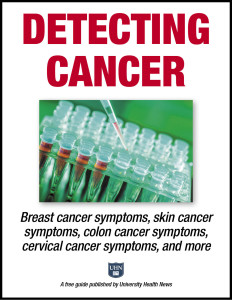Take Heed of Throat Cancer Symptoms
Your throat. A lot can happen to that 5-inch hollow tube that connects the base of your nasal cavity to your windpipe and esophagus. A sore throat can silence your singing voice. Or a faulty pharynx (the medical name for the throat) may cause swallowing difficulties that can affect your appetite.
While in most cases these and other warning signs herald a cold or other benign condition, they also could be throat cancer symptoms.
According to the American Cancer Society, more than 15,000 Americans are diagnosed with throat cancer each year. If you experience any symptoms of throat cancer, especially if they linger, seek a medical evaluation from your physician.
Recognizing Throat Cancer Symptoms
Throat cancer is a broad term used to describe cancers that form in the pharynx, larynx (voice box), and the tonsils. More specifically, experts categorize throat cancer based on the area of the pharynx affected by the cancer:
- Nasopharynx: The upper section of the throat, located directly behind the nose; cancers in this area of the throat are relatively rare.
- Oropharynx: The middle portion of the throat, located behind the mouth; also includes the soft palate, tonsils, and the back of the tongue.
- Hypopharynx: The bottom section of the throat, where the pharynx meets the trachea and esophagus; adjacent to the larynx and often grouped with laryngeal cancer.
Cancer can affect more than one section of the throat and larynx, as well as the esophagus or trachea, at the same time.
Detect It Early!
Download this expert FREE guide, Detecting Cancer: Breast cancer symptoms, skin cancer symptoms, colon cancer symptoms, cervical cancer symptoms, and more.
Learn how to recognize cancer warning signs and make the best decisions for care and treatment.
Throat cancer symptoms may vary slightly depending on the area of the pharynx affected.
Symptoms common to all three types include a sore throat that does not go away, a lump in the throat or neck, and ear pain. Other, site-specific signs of throat cancer may include:
- Nasopharyngeal: A lump in the nose, nosebleeds, nasal blockages/difficulty breathing, headache, recurrent ear infections, ringing in the ear/hearing loss, difficulty opening the mouth, and facial pain or numbness.
- Oropharyngeal: Swallowing difficulties, trouble opening the mouth or moving the tongue, voice changes, unexplained weight loss, and coughing up blood.
- Hypopharyngeal: Swallowing problems and voice changes.
In addition to throat cancer, several non-cancerous medical conditions may cause these symptoms, so it’s important to see your physician to get the right diagnosis.
Your doctor and dentist should examine your oral cavity and oropharynx as part of routine checkups. Also, regularly look at your mouth and throat in the mirror, and tell your healthcare professional about any abnormalities you notice.
No simple screening tests for throat cancer are available, so routine screening generally is not recommended. Sometimes, throat cancer may offer no warning signs until it becomes advanced.
But, in some cases it’s still possible to detect the disease in its earlier, more treatable stages because certain throat cancer symptoms, such as voice changes, may develop fairly quickly in the disease process. As such, see your doctor if you develop any signs of throat cancer so you can start prompt treatment.
Know Your Risk
Throat cancer is more common in older adults and among men. Although there’s nothing you can do about your age or gender, you can take steps to prevent other, modifiable throat cancer risk factors.

Cigarette smoking: It’s a dangerous habit that raises one’s risk factor for throat cancer, according to research.
As with other cancers, smoking and other forms of tobacco use are a strong risk factor for throat cancer, particularly oropharyngeal, hypopharyngeal, and laryngeal cancers. Alcohol consumption, especially excessive drinking, also increases the risk of throat cancer.
Combining tobacco and alcohol use multiplies the risk. For instance, some research suggests that heavy drinkers and smokers may be up to 100 times more likely to develop oropharyngeal cancer compared to those who don’t drink or smoke, the American Cancer Society notes. By quitting or refraining from smoking and limiting or avoiding alcohol consumption, you may reduce your risk of throat cancer.
Another risk factor for oropharyngeal and hypopharyngeal cancers is human papillomavirus (HPV) infection. (Infection with another virus, Epstein-Barr, is linked to nasopharyngeal cancer.) HPV encompasses more than 150 viruses—HPV 16 is the type associated with throat cancer.
Perhaps most widely known for its role in cervical cancer, HPV also can cause throat cancer, although only a small percentage of people with HPV infection develop throat cancer. The virus can be transmitted from person to person via skin-to-skin contact or during sex.
Some studies have found that the risk of HPV infection of the mouth and throat is greater in men and is tied to sexual activities such as oral sex and open-mouth kissing. The risk of infection also increases with the number of sexual partners you have. Talk to your doctor about your risk of HPV infection and whether you should consider vaccination against HPV.
Originally published in August 2016 and updated.
The post Take Heed of Throat Cancer Symptoms appeared first on University Health News.
Read Original Article: Take Heed of Throat Cancer Symptoms »
Powered by WPeMatico


